Understanding the Overlap of Autism and Mental Health Challenges
Autism spectrum disorder (ASD) and depression are interconnected conditions that pose unique challenges for diagnosis and treatment. With studies indicating that autistic individuals are significantly more vulnerable to depression, a comprehensive understanding of their relationship, manifestation, causes, and management strategies is essential for healthcare providers, caregivers, and the autistic community. This article explores the prevalence, symptoms, assessment challenges, risk factors, and current treatment approaches for depression in autism, emphasizing the importance of tailored care and increased mental health awareness.
Prevalence and Impact of Depression in Autistic People
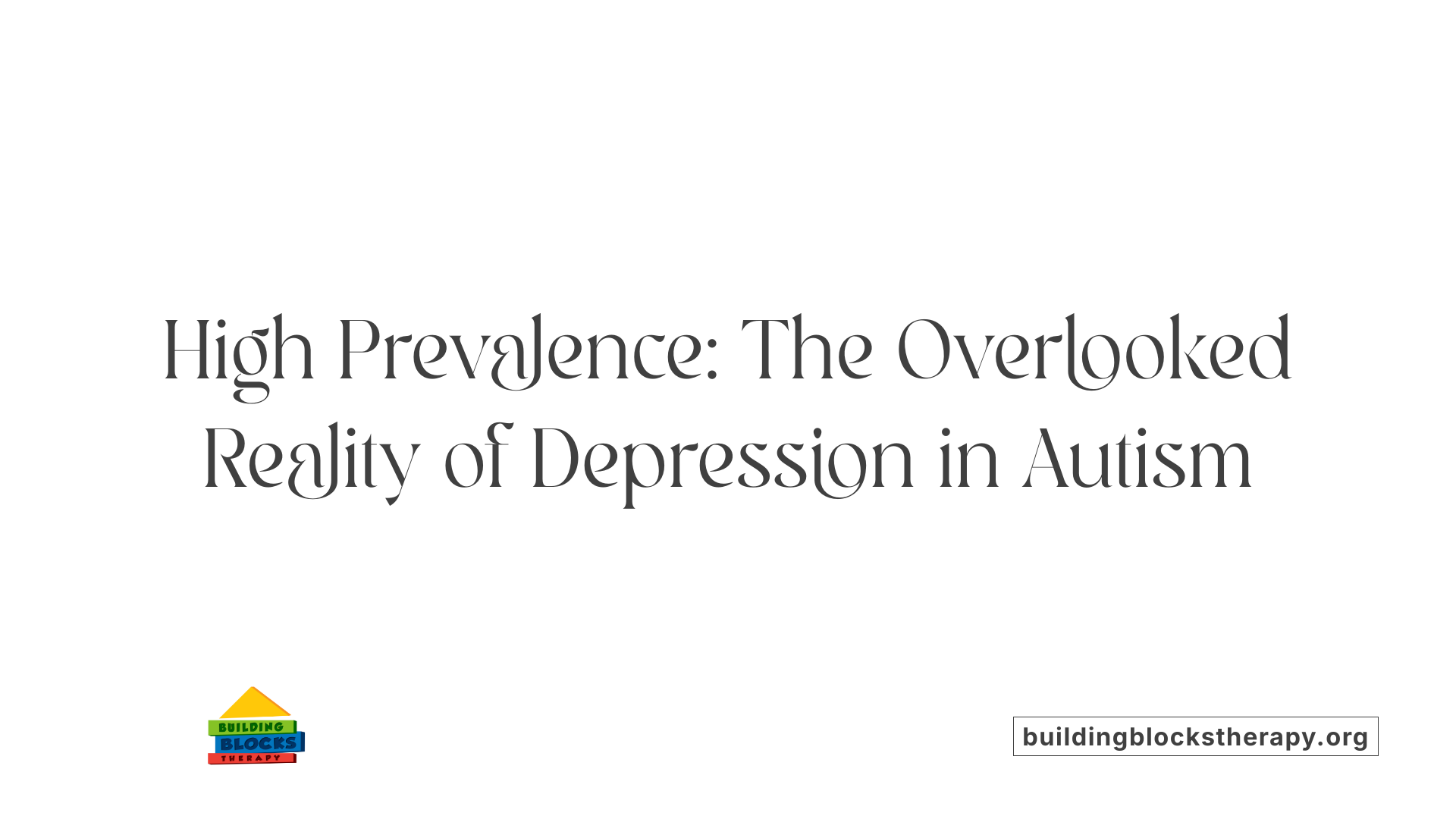
What is the relationship between autism and depression?
Autism and depression are separate conditions, but they often occur together. Research shows that autistic individuals are about four times more likely to develop depression compared to non-autistic people. Around 40% of autistic adults report experiencing depression at some point in their lives, and the rates are higher for youth, with studies indicating that approximately 20% of adolescents with autism have been diagnosed with depression.
Several factors explain this elevated risk. Autistic traits such as social difficulties, sensory sensitivities, and communication differences make emotional regulation and social engagement more challenging. Traits like alexithymia, which involves difficulty in understanding and expressing emotions, are common and strongly linked to depression.
Environmental stresses, including social stigma, bullying, and lack of support, further increase vulnerability. Additionally, high levels of worry and a perceived lack of control over life circumstances are central to depression in this group. These factors can lead to feelings of hopelessness, worthlessness, and social withdrawal. In some cases, depression may be masked by autism-related behaviors like repetitive actions or decreased motivation.
Diagnosing depression in autistic individuals is often complicated. Many symptoms—such as social withdrawal, physical complaints, changes in sleep or appetite, and loss of interest—overlap with autism traits, making it essential for clinicians to use tailored assessment tools. Because of communication difficulties, especially for those with limited speech, observing behavioral changes and gathering information from caregivers are vital.
The impact of depression on autistic people is profound. It can severely impair their daily functioning, independence, and social relationships. Furthermore, they are at a much higher risk of suicidal thoughts, with estimates suggesting that up to 66% of autistic adults have considered suicide, and approximately 35% have attempted or planned it. Untreated depression can lead to worsening of mental health and an increased burden on caregivers.
Understanding the high prevalence of depression among autistic individuals underscores the importance of customized support, early diagnosis, and effective treatment strategies. These might include adapted psychotherapies such as CBT and mindfulness, medication when appropriate, and social support networks. However, research into specialized interventions remains limited, highlighting the need for ongoing studies to improve therapeutic approaches.
| Population Group | Prevalence of Depression | Additional Notes |
|---|---|---|
| Autistic Adults | Up to 40% | Based on lifetime diagnosis or self-report |
| Autistic Youth | Estimated 8–20% | Higher subsyndromal depression rates (~10–15%) |
| General Population | About 6–7% | Significantly lower than autistic groups |
Autism and depression are intertwined, with the interplay of biological, psychological, and social factors creating a complex picture. Recognizing and addressing depression in autistic individuals is crucial for improving their quality of life and well-being.
Manifestation of Depression in Autistic Individuals
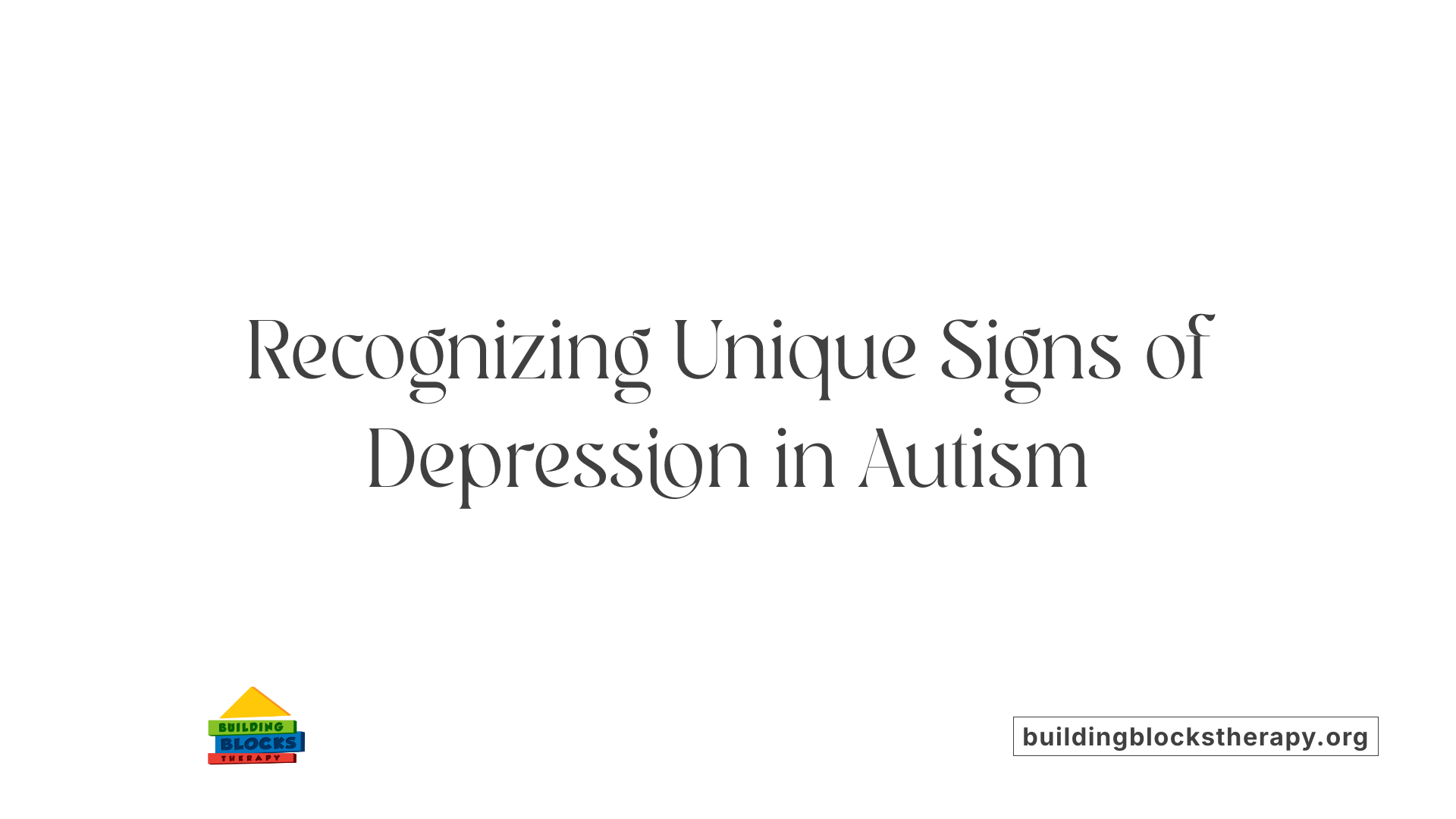
How does depression manifest in autistic individuals?
Depression in autistic individuals can show both familiar and unique signs, making recognition challenging. Traditional symptoms like deep, ongoing sadness, feelings of hopelessness, and a loss of interest in previously enjoyed activities are common indications. However, due to differences in communication styles and sensory sensitivities, these symptoms may appear differently.
Autistic people might display increased irritability or aggressive outbursts instead of verbal expressions of despair. Social withdrawal or avoiding interactions may be more noticeable because of social difficulties innate to autism, rather than purely depressive withdrawal. Changes in routines, special interests, or repetitive behaviors might also reflect depressive states—either as a symptom or a response to emotional distress.
Sleep and appetite disturbances—such as insomnia, fatigue, weight changes, or eating issues—are common in depression, but can be mistaken for typical autistic traits. Self-harming behaviors or increased meltdowns could signal depressive feelings or worsening mental health, especially when behaviors become more intense or persistent.
Physical symptoms, including fatigue and somatic complaints, are also frequently observed. Anxiety may coexist or be exacerbated, compounding the presentation.
Communication differences, such as alexithymia—difficulty identifying and describing emotions—can mask or obscure internal feelings of depression, leading to underdiagnosis.
Recognizing depression in autistic people requires careful observation from multiple sources, including family, caregivers, and mental health professionals. Since symptoms can overlap or be expressed atypically, using adapted assessment tools and approaches is crucial.
Therapeutic strategies tailored to individual needs, such as modified cognitive-behavioral therapy that incorporates concrete language and focuses on special interests, can improve diagnosis and treatment. Overall, understanding these varied manifestations helps in providing timely support to autistic individuals experiencing depression.
Causes and Risk Factors for Depression in Autism
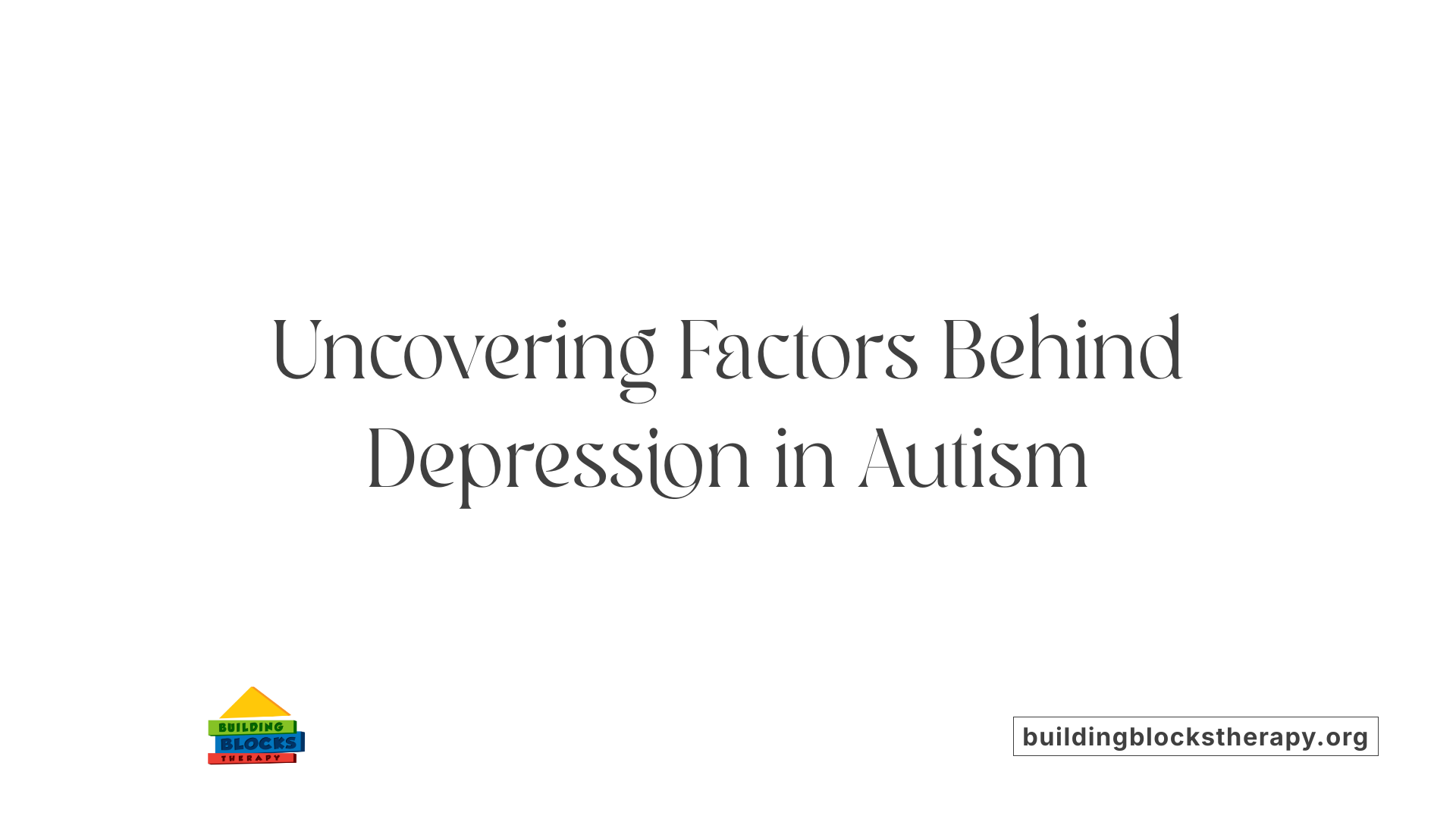
What are the common causes and risk factors for depression in autistic individuals?
Depression in autistic individuals often stems from a complex interplay of biological, psychological, and environmental influences. Social factors play a significant role; many autistic people experience social isolation, misunderstanding, and rejection from peers and the broader community. These experiences of feeling misunderstood or not accepted can heighten feelings of anxiety and hopelessness, contributing significantly to depression.
Sensory sensitivities and communication difficulties further exacerbate emotional struggles. Autistic individuals may find certain sounds, lights, textures, or social cues overwhelming or confusing, leading to frustration and fatigue. Additionally, many autistic people experience alexithymia — a condition characterized by difficulty in identifying and expressing emotions — which can mask or complicate depression diagnosis.
Genetic and neurobiological factors also influence the risk. Studies suggest that genetics, brain structure, and neurochemical differences may predispose some autistic individuals to mood disorders like depression. External stressors are equally impactful. Experiences of bullying, social rejection, and a lack of appropriate support or accommodations increase vulnerability.
Certain traits associated with autism, such as perfectionism, obsessive behaviors, and a tendency to overthink negative emotions, also play a part. These characteristics can lead to rumination — persistent negative thinking — and difficulty shifting focus away from distress. Sleep disturbances common in autism can weaken emotional resilience, heightening susceptibility.
Environmental influences, including traumatic experiences or exposure to chronic stress, substantially raise the risk of depression. The cumulative effect of social exclusion, sensory overload, and emotional regulation challenges creates a heightened state of distress.
Overall, these factors do not act in isolation but interact to produce a greater vulnerability to depression in autistic individuals. Recognizing these causes is essential for developing tailored interventions and supportive environments that can mitigate some of these risks.
Challenges in Diagnosing Depression in Autistic People
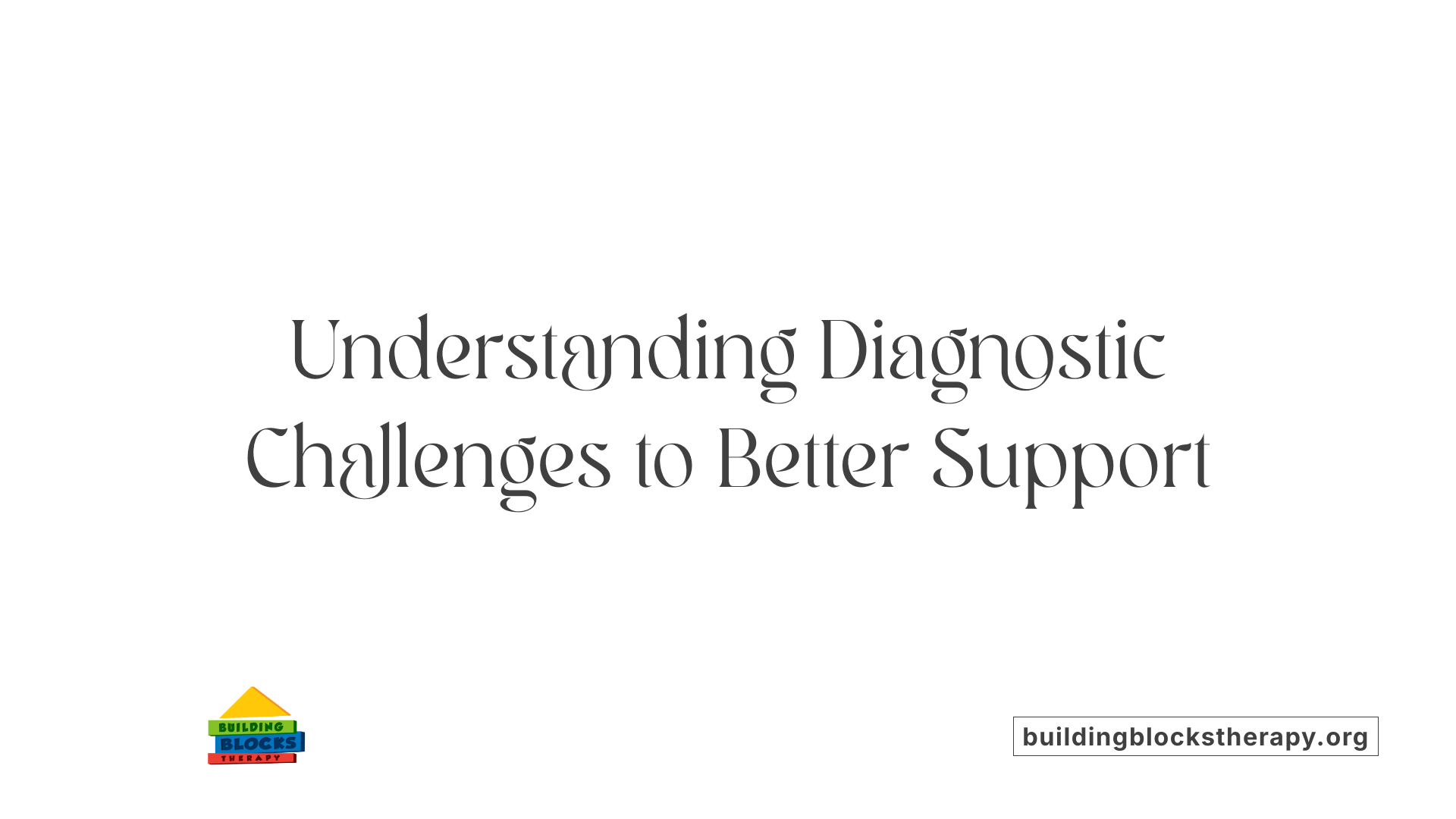
What are the challenges in assessing and diagnosing depression in autistic individuals?
Diagnosing depression in autistic individuals presents multiple unique difficulties that can hinder accurate identification and timely intervention.
One significant challenge is the overlap between symptoms of autism and depression. For example, social withdrawal, difficulty with communication, and reduced interest in activities can be seen in both conditions, making it hard to distinguish whether these behaviors are part of autism or indicative of depression.
Autistic individuals often express emotional distress differently. They might show irritability, agitation, or physical complaints instead of the typical signs such as persistent sadness or tearfulness. This atypical presentation can lead to under-recognition of depression.
Standard assessment tools used for depression, like the Beck Depression Inventory-II (BDI-II), may not be fully effective for autistic populations. Although some studies have validated these tools for autistic adults, the existing measures may still lack sensitivity to the unique ways depression manifests in autism.
Communication difficulties further complicate diagnosis. Many autistic people have limited verbal abilities or struggle to express their internal emotional states accurately. Consequently, relying solely on self-report may not be reliable, and observations by clinicians or caregivers become crucial.
Behavioral masking and suppression are common coping mechanisms used by autistic individuals to hide distress. This intentional or subconscious hiding of feelings can obscure symptoms of depression, delaying diagnosis.
The variability in symptom presentation underscores the importance of multi-informant assessments. Combining input from self-reports, caregiver reports, and clinical observations helps in forming a comprehensive understanding.
Overall, there is an urgent need to develop specialized, psychometrically validated tools tailored for autistic individuals to improve detection. Continued research aims to refine assessment methods, ensuring they are sensitive enough to identify depression accurately within this neurodiverse population.
| Challenge | Description | Impact |
|---|---|---|
| Symptom Overlap | Autism and depression share behaviors like withdrawal and reduced interest | Can lead to misdiagnosis or missed diagnosis |
| Atypical Expression | Emotional distress may manifest as irritability or physical complaints | Difficult to assess using standard tools |
| Communication Barriers | Limited speech or expressive difficulties | Reduces accuracy of self-report |
| Masking Behaviors | Camouflaging feelings to hide distress | Conceals symptoms, delaying recognition |
| Need for Adapted Tools | Lack of sufficiently sensitive assessment instruments | Impacts diagnosis accuracy |
Given these challenges, healthcare providers are encouraged to adopt a multi-method, multi-informant approach, integrating clinical interviews, caregiver inputs, and behavioral observations. Recognizing the diversity in how depression presents in autism can lead to earlier, more effective treatment, ultimately improving mental health outcomes.
Treatment and Support Strategies for Depression in Autism
What treatment options and therapies are available for depression in autistic individuals?
Treating depression in autistic individuals involves a combination of specialized therapies, medication, and lifestyle adjustments, all tailored to fit each person's unique needs. Because autism is highly individual, interventions often require modifications to traditional approaches to ensure they are accessible and effective.
Psychotherapy plays a vital role. Adapted cognitive-behavioral therapy (CBT) is one of the most studied methods. This version of CBT uses concrete language, visual aids, and often incorporates special interests to help improve engagement. Mindfulness-based therapies, which focus on increasing present-moment awareness, have also shown promise in reducing depressive symptoms.
Medications such as selective serotonin reuptake inhibitors (SSRIs) — including Prozac and Zoloft — may be prescribed for moderate to severe depression. However, their use calls for caution. Autistic individuals can be more sensitive to medication side effects, so close monitoring is essential. Currently, research on the effectiveness of SSRIs specifically in autism remains limited, and they should be considered part of a comprehensive, personalized treatment plan.
Support networks and lifestyle strategies form a crucial part of managing depression. Maintaining structured routines, improving sleep hygiene, and engaging in supportive social activities can provide stability. For individuals with sensory sensitivities, creating a calm environment and using sensory tools can help them cope with stress.
Interventions should also include practical approaches that respect communication differences and sensory needs. Speech and occupational therapies can be integrated with mental health treatments to address challenging behaviors or sensory overload.
Ultimately, a multidisciplinary approach involving mental health professionals, medical providers, family, and educators enhances the effectiveness of treatment. Regular assessment and flexibility in therapy ensure that interventions remain aligned with the individual’s evolving needs. Because autism manifests differently across individuals, personalized, ongoing evaluation is vital for optimal support and recovery.
Overlap, Distinctions, and Autistic Burnout
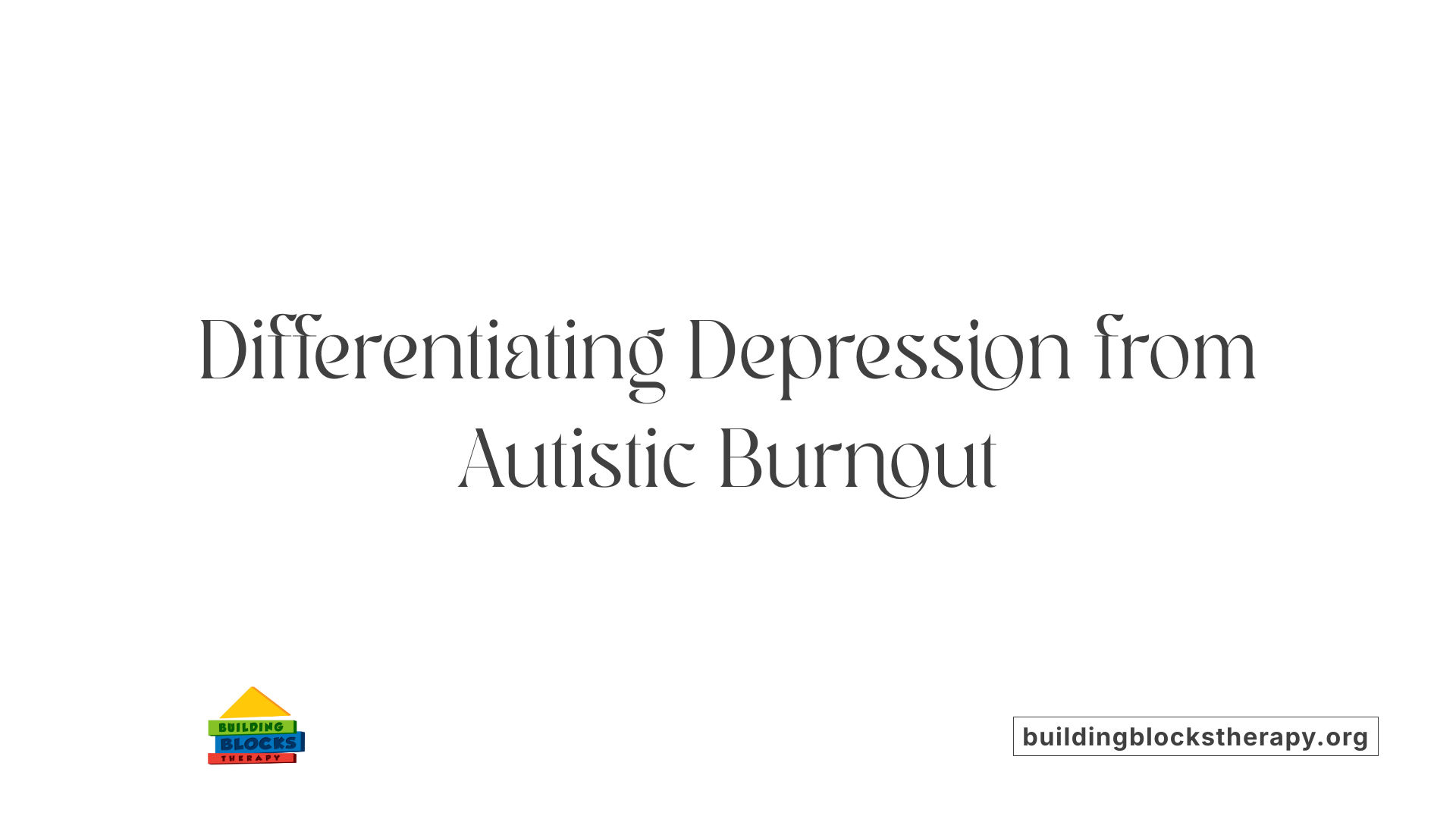
How do autism and depression overlap or differ, and what is autistic burnout?
Autistic burnout is a phenomenon particularly experienced by autistic individuals, characterized by a deep, pervasive state of exhaustion affecting physical, mental, and emotional well-being. It often manifests as increased sensory sensitivities, loss of skills like executive functioning and communication, and difficulty coping with social and environmental demands.
While some symptoms of burnout, such as fatigue, social withdrawal, and emotional exhaustion, can resemble depression, they originate from different causes. Depression is often rooted in internal neurochemical imbalances, leading to persistent sadness, feelings of worthlessness, and loss of pleasure. In contrast, autistic burnout is mainly an externalized response to ongoing stressors—such as constant masking, sensory overload, and societal pressures—that overwhelm the individual's capacity to cope.
Autistic burnout is typically triggered by external factors: prolonged stress, demands to mask or hide autistic traits, sensory overload from overwhelming environments, or changes in routine and social expectations. It arises from chronic mismatch with a neurotypical environment, leading to a breakdown in functioning. On the other hand, depression may develop independently of external stressors due to biological factors, though it can also be exacerbated by stressful life events.
Both conditions can coexist, with burnout potentially precipitating or worsening depression if left unmanaged. Recognizing the distinction is important because their treatments differ. Recovery from burnout emphasizes environmental management:
- Setting boundaries to avoid overload
- Engaging in sensory regulation activities
- Resting and prioritizing self-care
- Seeking support from trusted communities
These strategies aim to reduce external stressors and restore balance.
Treating depression generally involves therapeutic interventions like psychotherapy—such as cognitive-behavioral therapy adapted for neurodivergent individuals—and medication, focusing on internal emotional and neurochemical regulation.
Understanding these differences enables tailored approaches. While burnout can often be alleviated through environmental adjustments and self-management, depression may require ongoing mental health treatment.
In summary, autistic burnout stems from external stressors and environmental mismatches that exhaust the individual’s coping resources, whereas depression involves internal neurochemical factors. Both conditions significantly impact an autistic person’s quality of life, but groupings of symptoms and treatment strategies should be clearly distinguished to promote effective support and recovery.
Current Research and Future Directions
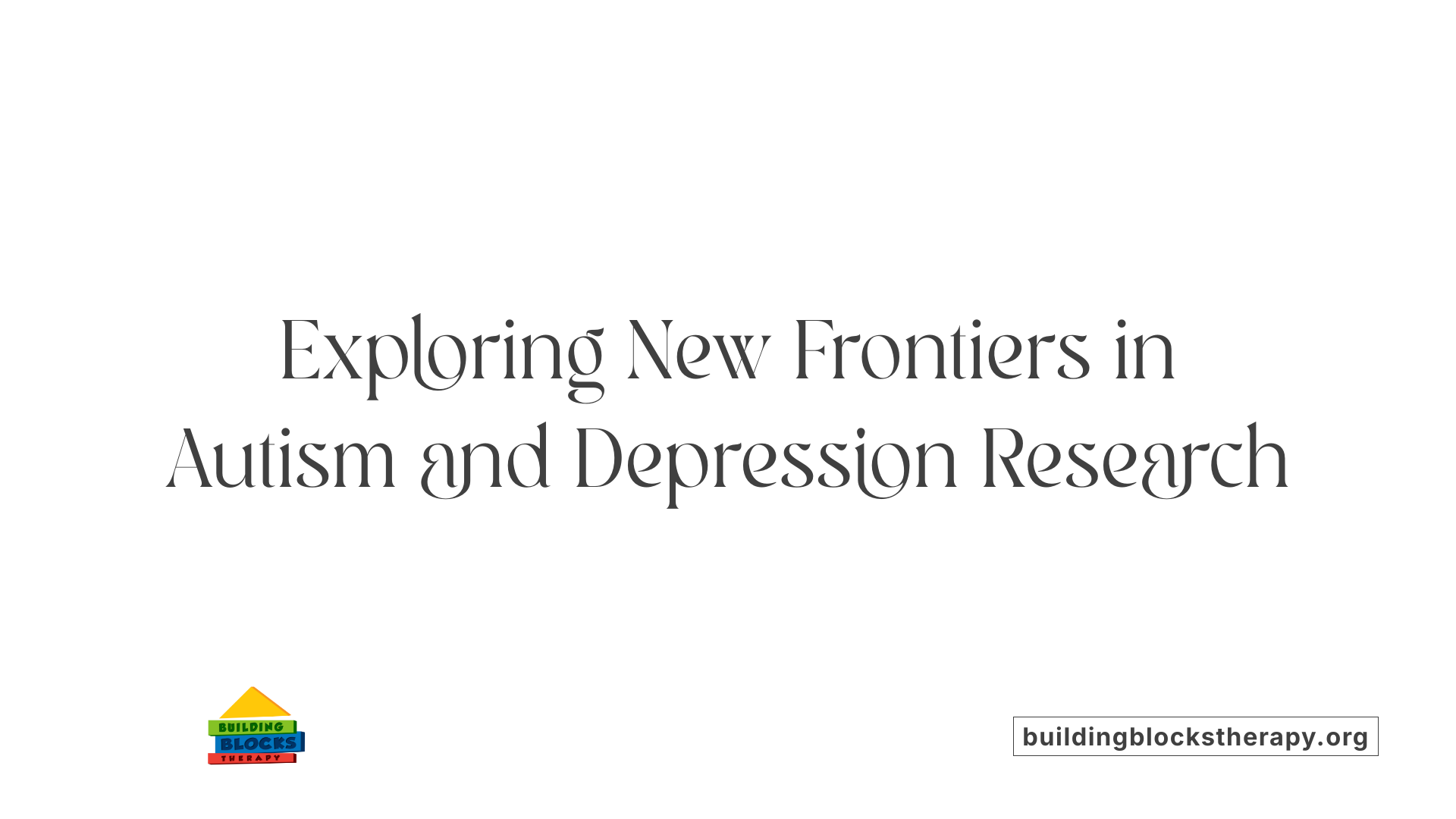
What does current research reveal about autism and depression?
Recent studies underscore that depression is highly prevalent among autistic individuals. Estimates show that up to 40% of autistic adults may experience depression at some point in their lives, while around 8% of children with autism are affected. In youth, prevalence rates, based on parent reports, range from 1% to 10% for diagnosed depression, with an additional 10-15% experiencing subsyndromal symptoms.
Diagnosing depression in autism can be particularly challenging due to overlapping symptoms like social withdrawal, physical complaints, and changes in interests, which are also common autism traits. This complexity often leads to underdiagnosis or misdiagnosis, delaying critical treatment.
The risk of suicidal thoughts and actions is significantly higher in autistic individuals, especially adults, with studies indicating that almost nine times more autistic adults contemplate suicide compared to non-autistic peers. This alarming statistic highlights the urgent need for early detection and tailored interventions.
Research also explores how depression manifests differently in autistic people. Common symptoms include persistent feelings of hopelessness, social withdrawal, self-harm, sleep disturbances, and obsessive behaviors. Notably, atypical signs such as changes in special interests or a sudden increase in meltdowns can suggest depression.
Neural and genetic research
Emerging neuroscience research investigates potential neurobiological influences on depression in autism. Studies that utilize network analysis suggest that factors like perceived mastery and worry are central to connecting autism with depression. Autistic adults without depression tend to report more worries and less perceived control over their lives—similar patterns observed in depressed individuals.
Genetic studies are ongoing to identify markers that may predispose autistic individuals to depression. While specific genetic links have yet to be firmly established, findings suggest that genetic, environmental, and psychological factors intersect, influencing depression risk.
Treatment efficacy: psychotherapy and medication
Therapies like cognitive-behavioral therapy (CBT), adapted to accommodate neurodiversity, mindfulness-based interventions, and social skills training have shown promise in small-scale studies. These adapted therapies emphasize concrete language, focus on special interests, and incorporate sensory sensitivities to improve engagement.
Medication use, such as SSRIs, is considered cautiously due to limited evidence of effectiveness and potential side effects in autistic populations. While some medications are prescribed, especially in severe cases, there is a pressing need for more research into their safety and efficacy.
Overall, current evidence supports the use of psychological interventions, but their success depends heavily on individual adaptation and clinician expertise. Pharmacological treatments require careful monitoring, and clinicians must be vigilant about possible adverse effects.
Development of screening tools
Research efforts aim to develop better screening and diagnostic assessments tailored for autistic individuals. Since traditional depression criteria can be confounded by autism symptoms, innovative tools incorporate multi-informant reports, developmental considerations, and measures sensitive to atypical presentations.
Some initiatives involve combining observational data with self-reports and caregiver inputs, ensuring a comprehensive evaluation. Early identification of depressive symptoms is crucial for prompt intervention, which can significantly improve outcomes.
Importance of increased awareness and training
Education and training of healthcare professionals regarding autism-specific depression signs are vital. Many clinicians lack the resources or knowledge to accurately assess depression in autistic persons, leading to missed diagnoses.
Enhanced training programs focus on recognizing subtle or atypical symptoms, understanding communication differences, and employing appropriate assessment techniques. Increased awareness among parents, teachers, and caregivers can also facilitate earlier detection.
Efforts to raise awareness aim to destigmatize mental health issues in autism, promote routine screening, and ensure accessible, tailored treatment options. As research continues, the goal is to refine diagnostic tools, improve treatment efficacy, and ensure that autistic individuals receive comprehensive mental health support.
| Aspect | Current Focus | Future Directions |
|---|---|---|
| Prevalence | Up to 40% of adults, 8% of children experience depression | Improve prevalence estimates with standardized tools |
| Neural & genetic | Investigating biological markers and Worry/Mastery links | Further identify genetic and neurobiological pathways |
| Treatments | Adapted CBT, mindfulness, cautious medication use | Develop autism-specific therapies and optimized pharmacological options |
| Screening | Multi-informant, developmental tailored tools | Create more reliable, easy-to-administer screening instruments |
| Awareness | Training for healthcare professionals and caregivers | Expand education, reduce stigma, promote early intervention |
By advancing research in these areas, we hope to provide better preventative measures, diagnostic accuracy, and effective treatments for depression among autistic individuals, ultimately improving their quality of life and mental health outcomes.
Enhancing Support and Awareness for Better Outcomes
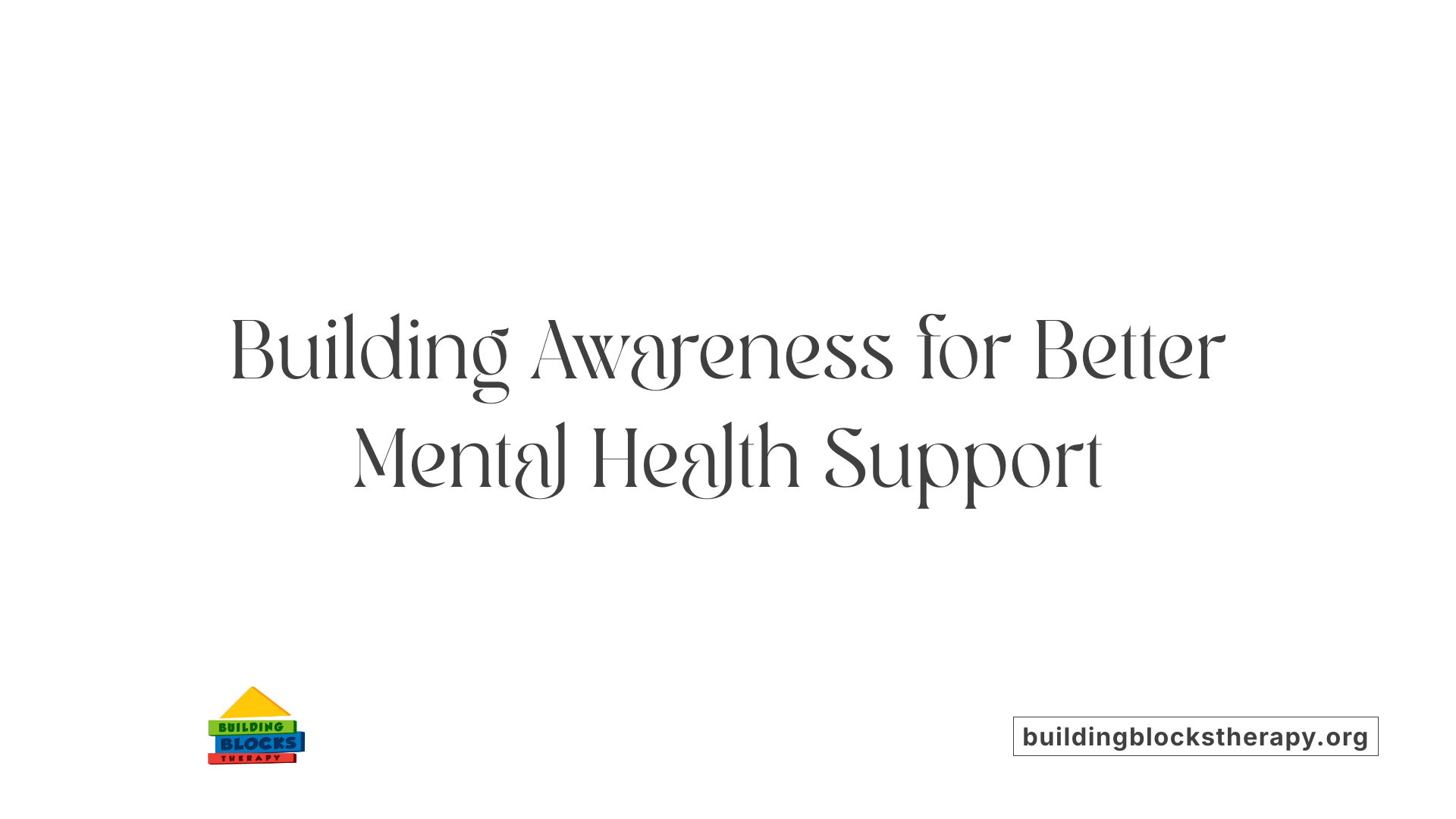
How can awareness of mental health issues improve support for autistic individuals?
Raising awareness about mental health challenges among autistic individuals plays a crucial role in improving their overall support system. When families, caregivers, educators, and healthcare providers understand the high prevalence of conditions like depression and anxiety in autism, they are more inclined to recognize early signs and intervene promptly. This early recognition can lead to timely diagnosis and treatment, reducing the risk of severe outcomes such as suicidal ideation or prolonged emotional distress.
Increased mental health literacy helps combat stigma and misconceptions surrounding autism, which often discourage individuals from seeking help. When society becomes more informed, autistic people experience a more accepting environment where their mental health struggles are acknowledged without judgment. This understanding promotes open conversations about emotional well-being, fostering self-advocacy and resilience among autistic individuals.
Moreover, heightened awareness encourages the adaptation of therapeutic approaches. Mental health professionals can tailor interventions like cognitive-behavioral therapy (CBT) or mindfulness-based therapies to suit the unique sensory, communication, and social needs of autistic clients. This customization improves therapy accessibility and effectiveness.
Recognizing the common co-occurrence of autism with other mental health conditions—such as obsessive-compulsive disorder (OCD), mood disorders, and trauma-related issues—leads to holistic and comprehensive support plans. These plans often involve multidisciplinary teams trained specifically in autism-related mental health care.
In addition, community and online support groups become more effective when mental health issues are openly discussed, providing peer support and shared coping strategies. Educational campaigns designed to increase understanding can reach wider audiences, including educators and employers, fostering inclusive environments that support mental well-being.
Ultimately, awareness acts as the foundation for building a supportive framework that emphasizes early intervention, reduces discrimination, and delivers personalized care. This creates a safer, more understanding space where autistic individuals can thrive emotionally, socially, and functional aspects of life.
Supporting Data and Strategies for Implementation
| Strategy | Description | Impact |
|---|---|---|
| Educational Campaigns | Public awareness campaigns to inform about autism and mental health | Earlier detection and reduced stigma |
| Professional Training | Specialized training for healthcare, educators, and service providers | Improved diagnosis, tailored interventions |
| Family and Caregiver Education | Providing resources and workshops for families | Better home support and advocacy |
| Peer Support Networks | Creating community groups for mutual aid | Emotional resilience and sharing coping techniques |
| Policy Advocacy | Promoting policies that support mental health access for autistic individuals | Increased funding and accessibility |
By implementing these strategies, society can foster environments where autistic individuals receive empathetic, effective, and personalized mental health care. This not only enhances their quality of life but also promotes broader societal acceptance and inclusion.
How can awareness of mental health issues improve support for autistic individuals? (Question)
Enhancing awareness of mental health issues within autism is fundamental to fostering supportive environments. It leads to earlier diagnosis, tailored interventions, and reduced stigma. When people are informed, autistic individuals and their families feel more empowered to seek help and advocate for their needs. Professionals trained in autism-specific mental health care are better equipped to recognize symptoms that may be masked or misunderstood due to autism traits. This understanding results in more effective treatment plans, encompassing therapy, medication, and lifestyle adaptations. Furthermore, increased awareness encourages community acceptance and understanding, which can significantly decrease social isolation, a major contributor to depression and other mental health challenges. Overall, education and awareness serve as catalysts for building inclusive, compassionate support networks that promote mental well-being and resilience.
Additional Resources
For more information on mental health and autism support, visit online communities, advocacy groups, and specialized healthcare providers. Awareness campaigns and training modules are available through organizations like the Autism Society, National Institute of Mental Health, and local mental health services. Engaging in continuous education and dialogue about mental health in autism can lead to meaningful change in how support is provided and perceived.
Final Notes
Improving mental health support for autistic individuals requires a collective effort rooted in knowledge, empathy, and action. Developing accessible resources, training, and policies that recognize the unique challenges faced by autistic people is essential. As awareness grows, so does the capacity of society to offer compassionate, effective support that enhances lives and fosters genuine inclusion.
A Call for Greater Understanding and Support
The intersection of autism and depression represents a critical area of need in mental health care. Given the heightened risk, unique symptom presentation, and diagnostic challenges, it is imperative that clinicians, caregivers, and the community work together to improve detection, tailor treatments, and reduce stigma. Advances in research, increased awareness, and accessible support resources are essential to improving outcomes and quality of life for autistic individuals facing depression. Emphasizing empathy, personalized interventions, and ongoing education will foster a more inclusive and supportive environment where autistic people can thrive and access the mental health care they deserve.
References
- Depression and autism | What is autism? - Autistica
- Depression in autistic people: Symptoms, treatment, and more
- Depression in Youth With Autism Spectrum Disorder - PMC
- Depression - National Autistic Society
- Autism and depression are connected: A report of two ...
- Autism and depression: What is the connection?
- Autism and Depression: What's the Relationship? - Healthline
- Autism and Depression






